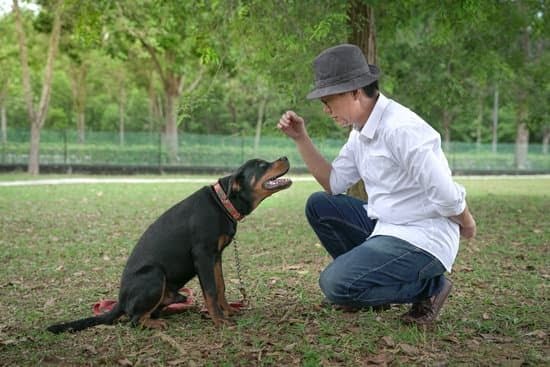How do you train your dog to howl? Training your dog to howl can be a fun and rewarding experience for both you and your furry friend. Understanding the basics of dog howling is the first step in successfully teaching your dog this unique behavior. In this article, we will explore the instinctual behavior of howling in dogs, as well as provide key tips and a step-by-step guide for training your dog to howl.
Dogs have been howling for centuries, using it as a form of communication with their pack or as a way to express themselves. It’s essential to understand why dogs howl and what triggers this behavior in order to effectively train them. By recognizing your dog’s triggers for howling, you can establish an effective communication with your pet and build a stronger bond.
In the following sections, we will delve into the reasons behind why dogs howl, explore the instinctual behavior of howling, and provide valuable insights into getting to know your dog’s triggers for howling. Additionally, we will offer key tips for training and a detailed step-by-step guide to teaching your dog to howl.
So, if you’re curious about training your dog to howl or want to strengthen your bond with your pet through this unique form of communication, keep reading.
Why Do Dogs Howl
The Instinctual Nature of Howling
Dog howling is an instinctual behavior rooted in the wild ancestry of our canine companions. In the wild, howling served as a means of communication and coordination among packs of wolves. Even though domesticated dogs have evolved from their wolf ancestors, they still retain some of these primal instincts, including the urge to howl.
Expressing Emotions
One of the primary reasons dogs howl is to express their emotions. Whether they are feeling lonely, anxious, or excited, howling can be their way of communicating these feelings to their owners or other dogs in the vicinity. Furthermore, dogs may also howl in response to certain sounds like sirens or musical instruments.
Maintaining Social Bonds
In addition to expressing emotions, dogs may also howl as a way to maintain social bonds with members of their pack. This can be especially true for dogs that are left alone for long periods of time. Howling can serve as a means for them to communicate with other dogs in the area and reaffirm their presence within their “pack”.
Understanding why dogs howl is crucial in training them to do so on command. By recognizing the instinctual nature behind this behavior, dog owners can effectively work towards teaching their pets how to howl when prompted.
Getting to Know Your Dog
Understanding the triggers for your dog’s howling behavior is an essential part of training your furry friend to howl on command. Dogs can howl for a variety of reasons, and recognizing these triggers will help you understand the communication signals your dog is trying to convey.
One common trigger for dog howling is separation anxiety. When a dog is left alone or feels isolated, they may begin to howl as a way to communicate distress and seek comfort. Other triggers include responding to high-pitched sounds such as sirens or musical instruments, communicating with other dogs in the area, or simply seeking attention from their owners.
To identify your dog’s specific triggers for howling, it’s important to observe their behavior in different situations. Take note of when they start to howl and what seems to provoke this behavior. This will provide valuable insights into your dog’s motivations for howling and help you tailor your training approach accordingly.
Recognizing your dog’s triggers for howling is the first step towards effectively training them to do so on command. Understanding why your dog howls will not only strengthen your bond but also improve communication between you and your canine companion.
| Triggers | Description |
|---|---|
| Separation Anxiety | Dog may begin to howl when left alone or feeling isolated |
| Response to High-Pitched Sounds | Dogs may start howling in response to sirens, musical instruments, etc. |
| Communication with Other Dogs | Dogs may use howling as a form of communication with other dogs in the vicinity |
| Seeking Attention | Dogs may begin to howl as a way of seeking attention from their owners |
Establishing an Effective Communication With Your Dog
When it comes to training your dog to howl, establishing effective communication is the key to success. The first step in this process is building a strong bond with your furry friend. Spend quality time with your dog, engage in interactive play, and show them love and affection. This will create a sense of trust and understanding between you and your pet, making it easier for them to respond to your training efforts.
Another essential tip for effective communication is using positive reinforcement. When your dog exhibits any sign of howling, even if it’s just a small whimper, make sure to praise and reward them immediately. Positive reinforcement can be in the form of treats, verbal praise, or physical affection. This will help your dog associate howling with positive outcomes, encouraging them to continue this behavior.
Consistency is also crucial when establishing effective communication with your dog. Set clear boundaries and rules for howling, and make sure everyone in the household follows the same guidelines. Inconsistency can confuse your dog and hinder their progress in learning how to howl on command.
| Effective Communication Tips | Key Training Tips |
|---|---|
| Build a strong bond with your dog through quality time together. | Use positive reinforcement techniques such as treats and praise. |
| Show consistency in setting boundaries and rules for howling. | Avoid negative punishment or scolding when your dog attempts to howl. |
The Training Process
Understanding the Training Process
Before diving into the training process, it’s important to understand that teaching your dog to howl requires patience, consistency, and positive reinforcement. Some dogs may naturally be more inclined to howl, while others may require more time and effort. It’s essential to approach the training process with a calm and positive attitude, as your dog will pick up on your energy.
Step 1: Finding the Trigger
The first step in training your dog to howl is to identify what triggers their howling behavior. Some common triggers include sirens, music, or even other dogs howling. Pay close attention to your dog’s behavior and note when they are most likely to start howling. Once you have identified the trigger, you can use it as a tool during the training process.
Step 2: Encouraging Howling
Once you have determined the trigger for your dog’s howling, you can begin encouraging the behavior. When the trigger occurs, try to mimic the sound or encourage your dog with a verbal command such as “sing” or “howl.” You can also try playing recordings of other dogs howling to pique their interest. When your dog begins to make any noise resembling a howl, be sure to praise them and offer a treat as positive reinforcement.
By following these steps and remaining patient and consistent, you can train your dog to howl in a positive and rewarding way. Remember that every dog is different, so it’s important to tailor your training approach to suit your individual pet’s personality and needs. With time and dedication, you can successfully teach your furry friend this unique skill.
Common Challenges and How to Overcome Them
Training your dog to howl can be a fun and rewarding experience, but it may also come with its fair share of challenges. Here are some common challenges that you may encounter while teaching your dog to howl, along with tips on how to overcome them:
1. Lack of Interest: Some dogs may simply not be interested in howling, or may not understand what you’re trying to teach them. In this case, it’s important to be patient and persistent. You can try using high-pitched sounds or playing recordings of other dogs howling to pique your dog’s interest.
2. Distractions: Dogs can easily get distracted, especially when learning something new. If your dog seems more interested in the squirrels outside than in practicing howling, try conducting training sessions in a quiet and familiar environment. Minimizing distractions will help your dog focus on the task at hand.
3. Fear or Anxiety: Some dogs may feel anxious or fearful about practicing howling, especially if they are not used to making such vocalizations. It’s important to create a safe and positive environment for your dog during training. Use treats, praise, and plenty of encouragement to help build their confidence and make the training process enjoyable for them.
By understanding these common challenges and implementing strategies to overcome them, you can successfully train your dog to howl and strengthen the bond between you both.
- Be patient and persistent
- Minimize distractions during training
- Create a safe and positive environment for your dog
Building a Strong Bond
To build a strong bond using howling as a form of communication, consider the following tips:
- Be attentive to your dog’s emotions and body language
- Respond positively to your dog’s howling
- Howl along with your dog during training sessions
- Use howling as a way to check on each other’s well-being
By being attentive to your dog’s emotions and body language, you can better understand when they are expressing themselves through howling. Responding positively to their howls can encourage them to continue communicating with you in this manner. Additionally, participating in howling yourself during training sessions can demonstrate that you acknowledge and appreciate their efforts to communicate with you.
Incorporating howling as a form of communication can strengthen the bond between you and your dog. It allows for a unique method of interaction that creates an even deeper connection between the two of you. By recognizing and embracing this natural behavior, it enhances the overall quality of the relationship and strengthens the understanding between you and your furry companion.
Celebrating Success
In conclusion, training your dog to howl can be a fun and rewarding experience for both you and your furry friend. By understanding the basics of dog howling and exploring the instinctual behavior behind it, you can effectively recognize your dog’s triggers for howling and establish an effective communication with them. Through patience, consistency, and positive reinforcement, you can successfully teach your dog to howl on command.
As you progress through the training process, it’s important to anticipate common challenges and troubleshoot them accordingly. Whether it’s overcoming stubbornness or distractions, staying patient and persistent is key in achieving success. Building a strong bond with your dog through howling as a form of communication can further deepen your relationship and strengthen the connection between you.
By celebrating success through reinforcing howling behavior and encouraging healthy howling habits, you can encourage positive behavior in your dog. Remember to always be patient, kind, and consistent in your training efforts.
Ultimately, teaching your dog to howl not only provides mental stimulation but also creates a special way of communicating with them that strengthens the bond between you both. So keep practicing and enjoy the unique experience of hearing your beloved pet join in harmony with the sound of their own howl.
Frequently Asked Questions
Can I Teach My Dog to Howl?
Yes, you can teach your dog to howl. While not all dogs may naturally howl, many can be trained to do so with patience and positive reinforcement. It’s important to remember that not all dogs will be interested in howling.
How Can I Make My Dog Howl?
To make your dog howl, you can try playing recordings of other dogs’ howls and see if your dog responds by joining in. You can also try singing or making a similar sound yourself to encourage your dog to imitate you. Remember to reward and praise your dog when they attempt to howl.
What Triggers a Dog to Howl?
Several things can trigger a dog to howl, such as hearing certain sounds like sirens or musical instruments, feeling lonely or anxious, or trying to communicate with other dogs. Some breeds are more prone to howling due to their genetic predisposition, while others may not howl at all unless trained to do so.
Understanding the triggers for your specific dog’s howling behavior can help address any underlying needs or issues they may have.

Welcome to the blog! I am a professional dog trainer and have been working with dogs for many years. In this blog, I will be discussing various topics related to dog training, including tips, tricks, and advice. I hope you find this information helpful and informative. Thanks for reading!





